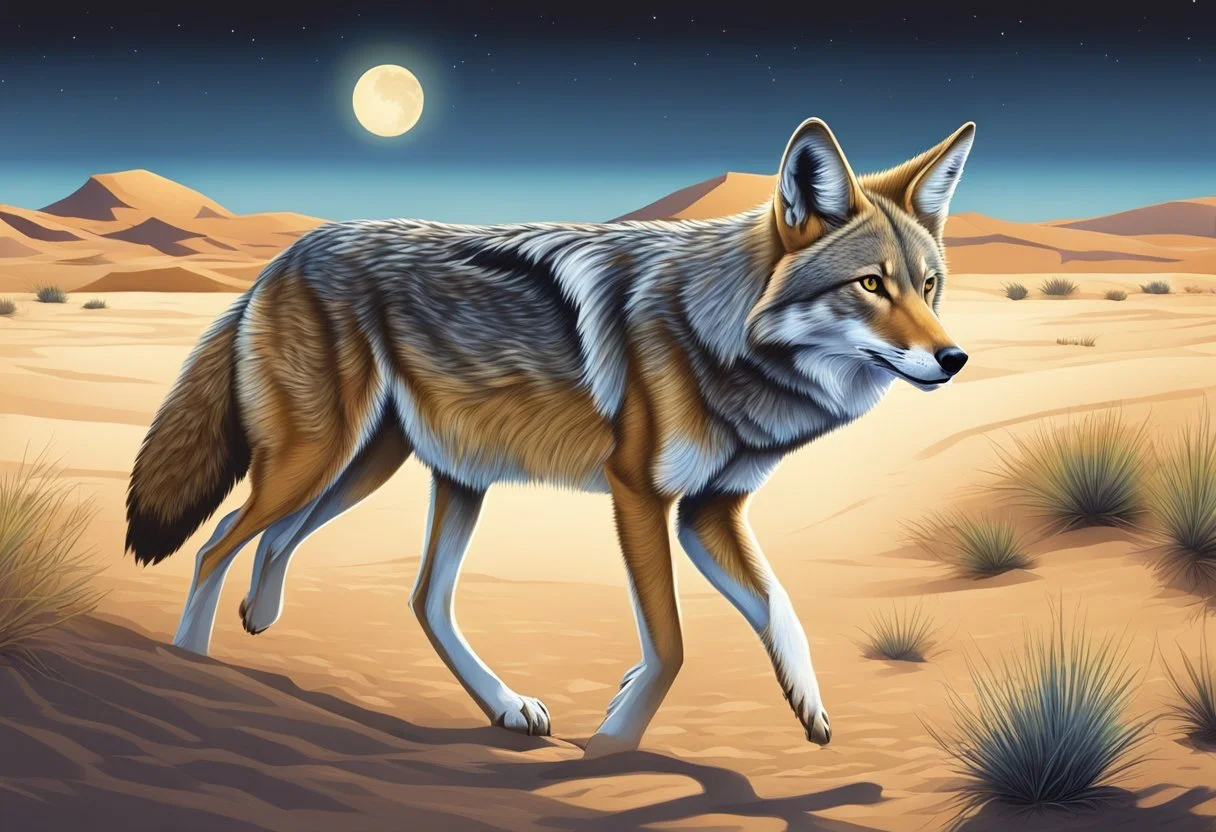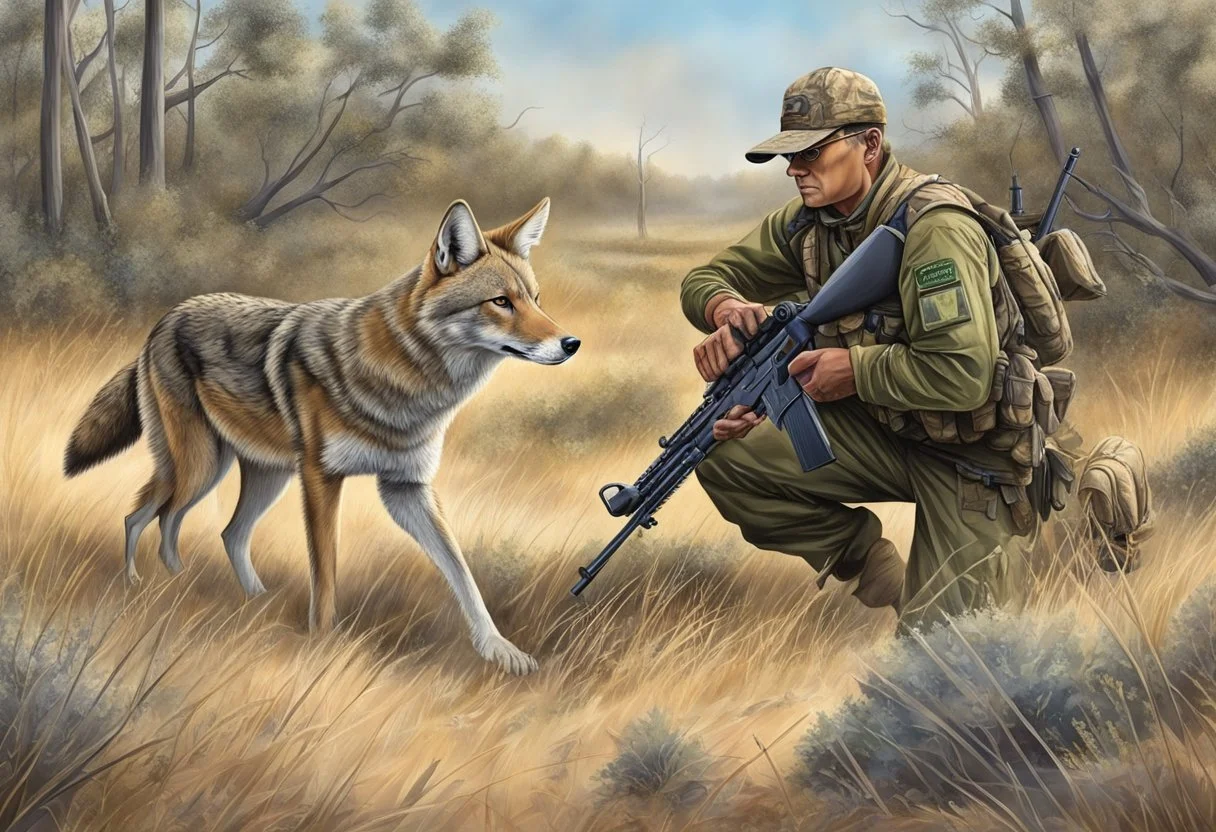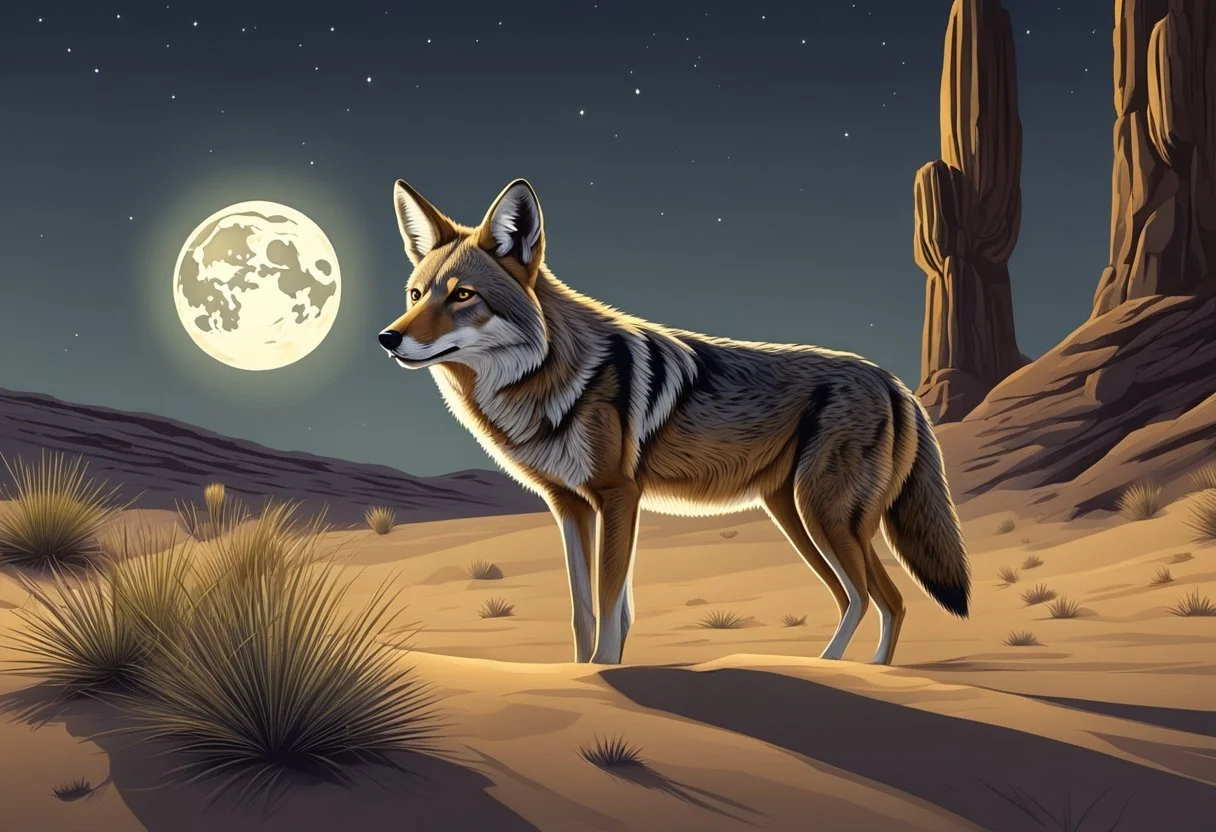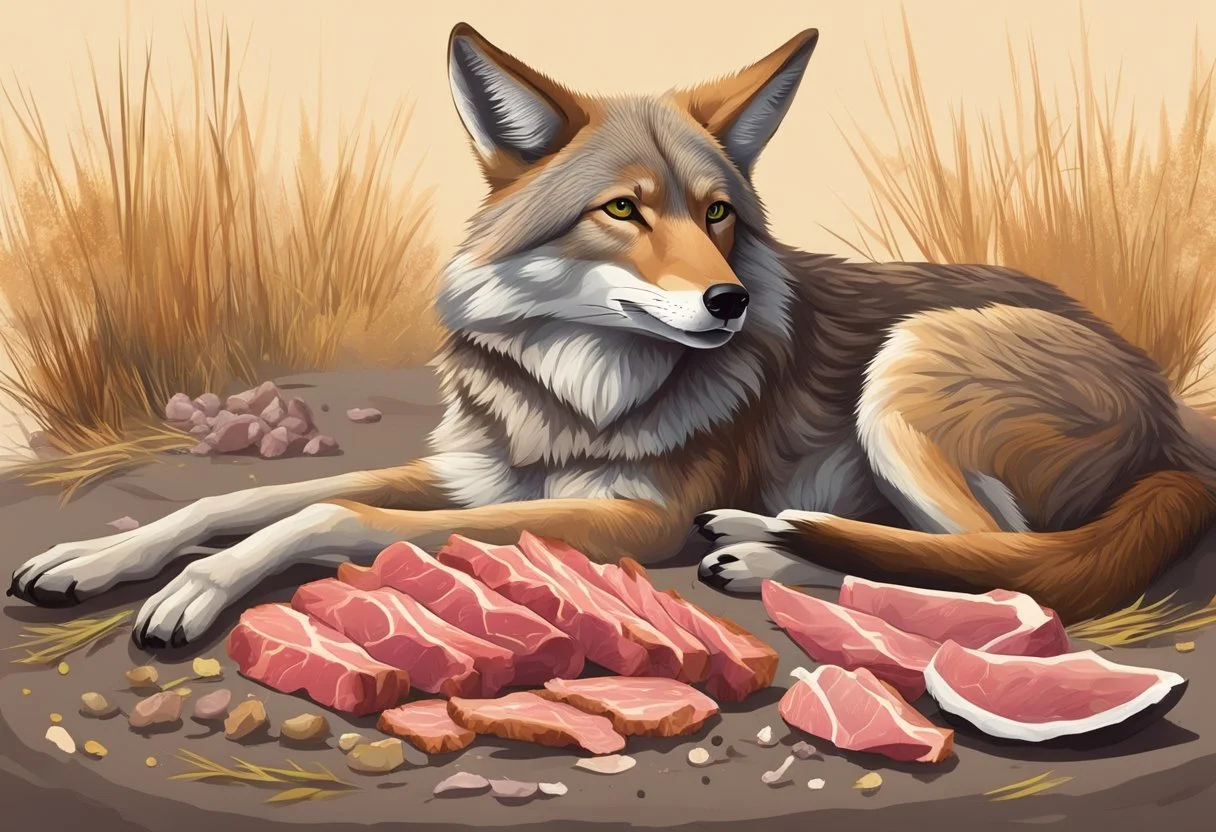Coyote Hunting for Beginners
Essential Tips for Success
Discover > Hunting for Dummies > Coyote Hunting for Beginners
Coyote hunting has become an increasingly popular outdoor activity for beginner and experienced hunters alike. These intelligent, adaptable predators can be found across North America, from dense forests to open grasslands. For newcomers to the sport, understanding the basics of the hunt is essential for a successful and enjoyable outing.
Starting with the right gear is crucial for any new coyote hunter. A reliable coyote hunting rifle or shotgun, suitable camouflage, and a comfortable pair of boots are just a few of the essentials that every hunter should have before venturing into the field. Additionally, understanding the behaviors and habits of coyotes can greatly increase the chances of a successful hunt.
To maximize the opportunities for a successful hunt, beginners should learn to utilize various hunting techniques such as calling, scouting, and using decoys. Conducting thorough research, honing one's shooting skills, and staying patient will also contribute to a more productive hunting experience. As with any outdoor pursuit, practice and experience are instrumental in refining one's coyote hunting skills.
Why Hunt Coyotes
Hunting Coyote is a popular outdoor activity with several benefits for both the environment and the hunter. Firstly, coyote populations have been rapidly increasing in recent years, which has led to growing concerns among livestock owners and farmers. These intelligent predators are known to cause significant damage by preying on farm animals and disrupting the balance of ecosystems.
Some reasons to hunt and kill coyotes now are:
Population control: As top predators, with few natural enemies, coyote populations can quickly grow out of hand. By hunting coyotes, hunters help maintain a balance in the ecosystem, preventing overpopulation.
Protecting livestock: Farmers and ranchers appreciate the assistance in keeping coyote numbers in check, as it helps protect their farm animals from potential attacks.
Hunting challenge: Coyotes are clever and elusive, making them an exciting challenge for both beginner and experienced hunters. Developing the skills to successfully hunt coyotes can be a rewarding pursuit.
Here are some notable advantages of coyote hunting:
Improving marksmanship: The small size, agility, and speed of coyotes make them a difficult target. Hunting them offers excellent opportunities to sharpen one's shooting skills.
Year-round hunting: Coyote hunting is a year-round activity in most areas, with no closed season. This makes it a great option for hunters looking to stay active and engaged during the offseason of other game species.
Sustainable resource: Coyotes reproduce at a rapid pace and can quickly recover their population. This makes coyote hunting a sustainable activity, providing a continued source of challenge and enjoyment for hunters.
In conclusion, hunting coyotes offers numerous benefits, such as population control, livestock protection, and skill development.
Understanding Coyotes
Coyote Adaptability and Predatory Behaviour
Coyotes are known for their exceptional adaptability predator hunters, which has allowed them to thrive in various environments across North America. They are versatile predators with a diverse diet that includes small mammals, birds, reptiles, and insects. Coyotes are also known to consume fruits and vegetables, showcasing their opportunistic feeding habits.
These predator hunting animals are cunning and have developed strategies to catch their prey efficiently. Their keen senses, such as acute hearing and a strong sense of smell, serve them well while hunting. With predator hunting, coyotes have an incredible nose, and even using Scent Killer Gold just as in deer hunting, it's still important to be aware of where the wind is blowing.
Coyotes often hunt in pairs or small packs of multiple coyotes, coordinating their efforts to increase their chances of success. However, they can also hunt solo when targeting smaller prey.
Coyotes have also demonstrated a remarkable ability to adapt to human environments. They can often be found in suburban and urban areas where they use their predator hunting skills to take advantage of the available resources, such as garbage or pet food left outdoors.
Coyote Habitats and Dens
Coyotes can be found in a wide range of habitats, spanning from forests and grasslands to deserts and urban areas. They are highly adaptable creatures, capable of adjusting to almost any environment. Their dens are crucial to their survival, serving as a safe place to birth and raise their young.
Here are some common types of habitats and den locations for coyotes:
Forests: Dens are usually located in thick brush, under tree roots, or in rock crevices.
Grasslands: They typically dig dens in well-drained soil, often on a slope or hillside.
Deserts: In arid regions, coyotes seek shelter in caves, rock crevices, or in dense shrubs.
Urban areas: Coyotes can adapt to urban living by finding shelter under buildings, in culverts, or in small patches of vegetation where they can employ their predator hunting ability.
Coyote dens are primarily used during breeding season for raising pups, and they may have several dens in their territory to ensure the safety and comfort of their offspring. They commonly use a den for a short period of time, then move their litter to a new location if they experience pup distress or if a previously used den becomes unsuitable due to flooding or predation risk. This adaptability significantly contributes to coyotes' success in various environments across North America.
Coyote Hunting Rules and Regulations
Hunting Licensing
Before embarking on a coyote hunting adventure, individuals must first acquire a hunting license from their respective state or province. Licenses can typically be obtained by completing a hunter education course and purchasing the license through an approved vendor or online. Be aware that licensing fees may vary by region, so it's crucial to check local regulations prior to acquiring a license.
Complete a hunter education course.
Purchase a hunting license through an approved vendor or online.
Hunting licenses often have expiration dates, so ensure that your license is valid during the time of your hunt. Additionally, some states or provinces may have specific regulations or restrictions in regards to hunting during certain seasons. Be sure to stay informed about hunting season and any changes in rules or regulations.
Hunting on Private Land
Hunting coyotes on private land requires permission from the landowner. It's important to gain written consent from the landowner before embarking on your hunt, as trespassing on private property without permission can result in fines or more severe consequences. Some hunters choose to form agreements with landowners, granting hunting access to public land in exchange for assistance with coyote control.
Gain written consent from the landowner.
Form agreements with landowners for hunting access in exchange for assistance with coyote control.
When hunting on private land, always be respectful of the land and landowner's wishes. Avoid causing damage to the property and always follow their established rules and guidelines for hunting on their land.
Preparation for Coyote Hunting
Equipment Selection
When preparing for a hunt, selecting the right equipment is crucial for the serious coyote hunter. Consider the following coyote hunting gear:
Weapons: Popular choices include rifles, shotguns, bows, and crossbows. Choose a weapon that you are comfortable with and always adhere to local hunting laws.
Ammunition: Be sure to bring enough ammunition for the entire hunt. Coyotes are elusive, so shots might be missed.
Optics: Scopes, lights, night vision, and thermal scopes are essential for spotting and targeting coyotes, especially during the evening and night hours. Choose optics that suit your hunting style and conditions.
Camouflage: Coyotes have excellent vision, so wear camouflage clothing and gear to help blend into the environment. This will increase your chances of getting closer to your target.
Coyote Scouting
Before embarking on a hunt, scout the area to improve your chances of success. Keep an eye out for the following signs:
Tracks: Look for coyote tracks in mud, sand, or soft soil. Coyote tracks are similar to medium-sized dogs' but have more elongated toes and a more triangular shape.
Droppings: Coyote droppings are tubular and tapered at the ends, often containing fur, bones, or small animal remains. Scat can help indicate the presence of coyotes in the area.
Coyote Vocalizations: Listen for coyote vocals such as coyote yips, howls, or barks. These can help pinpoint their location.
Practicing for the Hunt
To improve your chances of a successful hunt, practice your shooting skills before hitting the field. Focus on practicing with the weapon you plan to use during the hunt, as each type requires different techniques. Additionally, simulate real hunting scenarios by shooting from different positions and distances.
Remember that practice makes perfect, so invest time in honing your skills, familiarizing yourself with your equipment, and understanding the habits and behavior of coyotes. This preparation will set you up for a satisfying and successful coyote hunting experience.
Coyote Hunting Techniques
Using Distress Calls
One of the most effective techniques in the hunt for coyotes is the use of distress calls. These coyote sounds mimic the sounds of prey animals in distress, such as a rabbit distress call, bird, or even a coyote pup distress call. The coyote is an opportunistic predator hunter who can't resist the chance to investigate a potential meal. When using distress calls, hunters have two main options: mouth calls or electronic calls (e-callers).
Mouth calls require practice to master but electronic caller can allow for more control over the volume and pitch of the call. E-callers offer a variety of pre-recorded sounds that can quickly change to adapt to hunting conditions. Regardless of which type of call is used, hunters should set up in a location with adequate cover and position themselves downwind from the expected approach of the coyotes.
Coyote Luring Techniques
Aside from distress calls, using decoys and lures can greatly increase a hunter's chances of success. Decoys are used to create a visual representation of the prey animal, especially when combined with an effective rabbit distress call. This combination helps to convince a curious coyote that its meal is within reach. Lures, such as scents and urine, can be used to pique a coyote's interest and bring them within shooting range.
Decoys: Ensure the decoy is visible from a distance and set up in a location that entices the coyote.
Lures: Apply lures to objects near the decoy and surrounding areas that allow the scent to travel with the wind.
Stalking and Tracking
Understanding coyote movement patterns and being able to track them is crucial for successful hunts. Look for signs of recent coyote activity, such as tracks, scat, or prey remains. When stalking smart coyotes, stay aware of the wind direction to avoid getting noticed. Study the terrain and use cover to your advantage, moving quietly and patiently to get within shooting range.
Shot Placement Technique
Research your hunting tips well so proper shot placement enabled you to make an ethical and successful coyote hunt. It's important to be confident in one's shooting abilities, as well as understand the coyote's anatomy to make clean, humane shots that bring down the animal quickly. A popular method is aiming for the coyote's vital organs, such as the heart or lungs, which leads to a quick, ethical harvest.
To increase precision, equipment such as shooting sticks can be employed. They provide a stable shooting platform and can be easily adjusted for height or angled shots. Remember, practice makes perfect. Coyote hunters should regularly hone your shooting skills at a range to be fully prepared for a successful coyote hunt.
Advanced Hunting Techniques
Night Hunting
Night hunting can be an exhilarating experience for coyote hunters. The darkness adds an element of challenge, but it can also offer some advantages. To succeed in night hunting, it is essential to have the proper equipment. A high-quality spotlight or headlamp is crucial for locating coyotes in the dark. It's also helpful to use a red or green filter, as these colors are less likely to spook the animals.
For coyote hunters at night or early morning, consider using electronic calls. These devices can produce a variety of distress calls that draw coyotes closer. Playing recordings of rabbit, rodent, or bird distress sounds can be particularly effective at luring them in.
Remember to stay downwind from the direction you expect the coyotes to approach. This helps ensure that the animals will not detect your scent before they come within shooting range.
Use of Dogs in Hunting
Some coyote hunters use dogs as an effective strategy, but it requires some skill and training. There are two main roles that dogs can play in a hunt: decoy and tracker.
Decoy dogs: These dogs help attract coyotes by mimicking the behavior of a prey animal in distress. Some breeds, such as the cur or hound, are well-suited to this role. To train a decoy dog, teach basic obedience and implement various distress sounds when hunting.
Tracker dogs: These are trained to track the scent of a coyote and lead the hunter to its location. Breeds like bloodhounds and foxhounds excel in this role.
Role Breed Examples Decoy Cur, Hound Tracker Bloodhound, Foxhound
When hunting with dogs, it is crucial to ensure that they are well-trained and under control, so any nearby coyote isn't spooked.. Use electronic collars and leashes to maintain contact and control, especially in areas where other animals or hazards may be present.
Hunting tips recommend safety should always be a top priority when hunting with dogs. Ensure they are wearing high-visibility vests, making it easier for you to keep track of them and prevent accidental shootings. Moreover, make sure they are up-to-date on vaccinations and treated for any potential pests, such as ticks or fleas.
After the Hunt: Coyote Fur and Meat
Preserving the Fur
Once you have successfully killed coyotes, it is essential to preserve the fur properly. Before skinning the animal, put on gloves to protect your hands and ensure hygiene. Follow these steps to preserve your coyote fur effectively:
Carefully remove the entire pelt by making a cut along the center of the belly and down each leg, being cautious not to cut into the muscles.
Use a fleshing knife to gently remove any excess flesh and fat from the pelt.
Place the fur on a stretching board with the fur side down and pin it in place using tacks or nails.
Allow the pelt to air dry in a cool, well-ventilated area, away from direct sunlight and heat sources. The drying process typically takes 3-7 days.
Once the pelt is thoroughly dry, it's ready to be stored or sold.
Coyote Meat: A Delicacy or a Risk?
Coyote meat can be consumed, but it's important to consider the risks associated with it. Like other wild game, coyote meat carries the risk of parasites and diseases. To reduce the likelihood of these risks:
Inspect the carcass for any signs of disease, such as abnormal growths or discolored organs.
Properly clean the carcass, avoiding contact with fecal matter or urine, which could contain harmful bacteria.
When it comes to preparing and cooking coyote meat, it must be cooked to an internal temperature of 160°F (71°C) to ensure all harmful organisms are killed.
Wrap Up
Hunting coyotes can be a thrilling and rewarding experience for beginners if they follow some essential hunting tips above. To ensure a successful hunt, it's important to properly prepare, utilize the right gear, and implement effective hunting strategies.
When preparing for a coyote hunt, do some research and scout out potential hunting locations. Get familiar with the area's terrain and coyote activity. Don't forget to check the local regulations concerning coyote hunts, as they may vary depending on the region.
Having the appropriate gear is crucial for a successful hunt. Here's a quick checklist of essential items:
Firearm or bow: Choose one you're comfortable with, and make sure to practice your shooting skills.
Camouflage clothing: Dress according to the environment to remain concealed from coyotes.
Game calls: Invest in quality electronic or mouth calls to help lure the coyotes closer.
Scent control products: Block or mask human odor to remain undetected.
Optics: Bring binoculars or a spotting scope to survey the area and improve shot accuracy.
When it comes to strategies, consider the following:
Set up in an ideal location: Find a spot with good visibility and the wind in your favor, allowing you to catch approaching coyotes off guard.
Be patient: Allow time for the coyotes to respond to your calls. If unsuccessful, move to a new location and try again.
Utilize a decoy: A decoy can help distract coyotes, increasing your chances of a successful shot.
Adapt to the coyotes' behavior: Change your calling technique, decoy setup, or location based on observed coyote activity.
In conclusion, remember that improving as a coyote hunter takes time and dedication.








